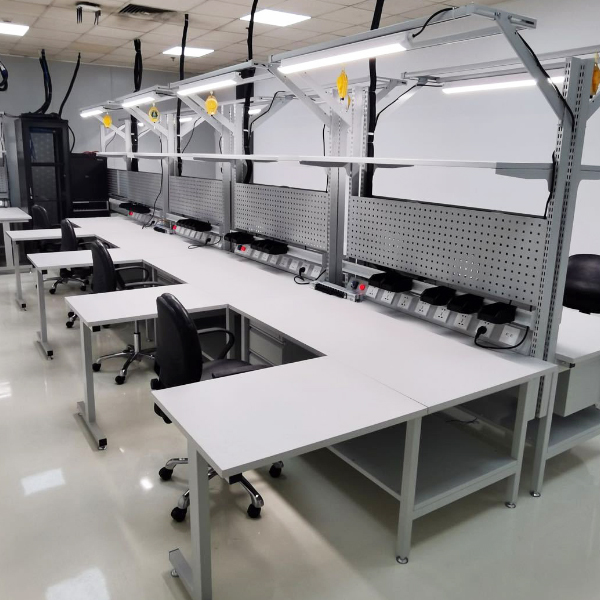Table of Contents
Proper maintenance and cleaning of ESD workbenches are essential to ensure their long-term performance and effectiveness in protecting sensitive electronic components. Over time, dust, debris, and improper handling can compromise the anti-static properties of these workbenches, leading to costly equipment failures in electronics manufacturing.
As an expert in ESD workbench maintenance, I will guide you through the best practices to care for your static control benches and ensure they perform at their peak for years to come.
Why Regular Maintenance Is Critical for ESD Workbenches
ESD (Electrostatic Discharge) workbenches are designed to prevent the buildup of static electricity, which can damage sensitive electronic components during the manufacturing process. While ESD workbenches come equipped with materials and grounding mechanisms to minimize static, regular maintenance is necessary to keep these features functioning properly.
Without proper care, contaminants can accumulate, and wear and tear can degrade the anti-static properties, potentially allowing static discharge to occur.
How To Properly Maintain The ESD Workbench?
Clean ESD Workbenches Regularly to Maintain Anti-Static Properties
Routine cleaning is the cornerstone of ESD workbench maintenance. Keeping the surface free from dust, dirt, and oils is crucial, as contaminants can interfere with the anti-static properties of the bench. However, it’s important to use the right cleaning products and techniques to avoid damaging the anti-static surfaces.
Best Practices for Cleaning ESD Workbenches:
- Use Anti-Static Cleaners: Avoid household cleaners, as they may leave residues that attract static. Opt for cleaning solutions specifically designed for anti-static surfaces. These cleaners are formulated to remove dirt while preserving the surface’s static-dissipative properties.
- Microfiber Cloths for Dusting: Use a microfiber cloth to gently wipe down surfaces, as these are soft and won’t scratch the bench. Make sure the cloth itself is clean and free of debris that could potentially damage the surface.
- Avoid Excess Moisture: When cleaning, lightly dampen the cloth—excessive water can seep into the workbench materials and disrupt their ESD properties. Make sure the bench is thoroughly dry before use to avoid static buildup.
Following a proper cleaning routine for anti-static surfaces helps ensure ESD workbenches continue to provide the required static control.
Inspect and Maintain Grounding Points
The grounding system is the heart of any static control bench. ESD workbenches typically come equipped with ground points, wrist straps, and grounding cables that prevent the buildup of static by channeling it safely to the ground. Over time, these components can wear out or become damaged, reducing their effectiveness.
How to Inspect and Maintain Grounding Systems:
- Check Connections Regularly: Inspect all grounding cables and connections for signs of wear or damage. Loose or frayed wires can compromise the static control system. Tighten or replace any components as necessary to ensure a solid connection.
- Test Grounding Points: Use an ESD tester to periodically test the bench’s ground points and wrist straps. Ensure that the readings fall within the acceptable range for ESD protection to confirm that the grounding system is working properly.
- Replace Worn-Out Parts: If any grounding components show signs of wear or malfunction, replace them immediately to avoid compromising the anti-static environment.
Regular ESD workbench maintenance includes inspecting grounding systems to ensure static is properly dissipated.
Prevent Surface Damage to Maintain Anti-Static Properties
The effectiveness of an ESD workbench depends largely on the condition of its surface. Scratches, gouges, and other forms of surface damage can degrade the anti-static properties and reduce its ability to protect electronic components.
Tips to Prevent Surface Damage:
- Use ESD Mats for Extra Protection: While most static control benches are built with anti-static surfaces, adding an additional ESD mat can provide extra protection. These mats are designed to absorb static while preventing physical damage to the workbench.
- Avoid Sharp Tools and Heavy Impacts: Be mindful of using sharp or heavy tools directly on the workbench. Dropping tools or components can cause dents or scratches that may interfere with the surface’s static-dissipative properties.
- Conduct Regular Visual Inspections: Routinely inspect the workbench for signs of wear or damage. If any deep scratches or cracks are present, consider resurfacing or replacing the anti-static top to maintain optimal performance.
Protecting the anti-static surface from damage ensures that your ESD workbench continues to offer reliable static control.
Maintain a Clean Work Environment
A clean work environment contributes significantly to the longevity of ESD workbenches. Dust, debris, and environmental contaminants can interfere with the performance of anti-static surfaces and may lead to static buildup.
How to Maintain a Clean Work Area:
- Regular Dusting: Dust and debris can accumulate not only on the bench surface but also in the surrounding area. Dust regularly, including under the bench and around the workspace, to minimize the presence of contaminants.
- Organize Tools and Components: Keeping tools and materials neatly organized helps prevent accidental damage to the bench. Use designated containers and holders for electronics components to avoid direct contact with the workbench surface.
- Control Humidity Levels: Humidity affects static electricity. In areas with low humidity, static discharge is more likely. Use a humidifier in dry environments to maintain an optimal humidity level for ESD protection.
A clean and organized environment is key to ensuring long-term performance for static control benches.
Educate Staff on Proper ESD Handling Procedures
Finally, proper ESD practices are only as effective as the people using them. Ensuring that staff members are trained in ESD-safe handling procedures will extend the life of your workbench and enhance the overall protection of sensitive components.
Staff Training and Best Practices:
- Wear Proper ESD Gear: Make sure that all workers handling sensitive electronics are using appropriate ESD wrist straps and footwear. Grounding workers is just as important as grounding the workbench.
- Handle Electronics in the Designated Area: Only handle sensitive electronic components on the ESD workbench. Avoid setting electronics on non-ESD surfaces, as static buildup from other areas can transfer to components.
- Regular Safety Audits: Conduct regular audits of your ESD procedures to ensure staff are following proper static control practices and that workstations are being maintained correctly.
Educating staff on ESD workbench maintenance and handling practices ensures the continued effectiveness of your static control bench.
Conclusion: Prolong the Life of Your ESD Workbench
Investing in an ESD workbench is essential for protecting sensitive electronics from the dangers of static discharge, but it’s equally important to maintain and clean the workbench regularly to ensure its longevity. By following the best practices outlined in this guide—ranging from cleaning anti-static surfaces to inspecting grounding points and training staff—you can extend the life of your workbench and ensure it continues to perform at its best.
Regular ESD workbench maintenance not only protects your equipment but also safeguards your production process from costly interruptions. Keep your workbench in top condition and enjoy the long-term benefits of a static-free workspace!




